News

Uplifter Explores The Evolving Processes Between PTSOs and Affiliated Clubs

Uplifter Explores The Evolving Processes Between PTSOs and Affiliated Clubs
3 min read
10 Nov 2025
Table of contents
In this blog post, we will take a look at the interconnection between Provincial/Territorial Sport Organizations (PTSO) and their affiliated clubs and teams in the context of the evolving processes for collecting and sharing member data, and the impacts these processes have on risk management, safe sport, and more.
So what has motivated this topic? Over the last 18 monthsUplifter has worked with over 100 diverse provincial bodies, covering 22 different sports from soccer to speed skating. The consistent reality is that it is difficult for PTSOs to find one model that works for all of their clubs/ teams and that there is an increasing need for PTSOs to create a direct and meaningful relationship with their club’s participants and parents.
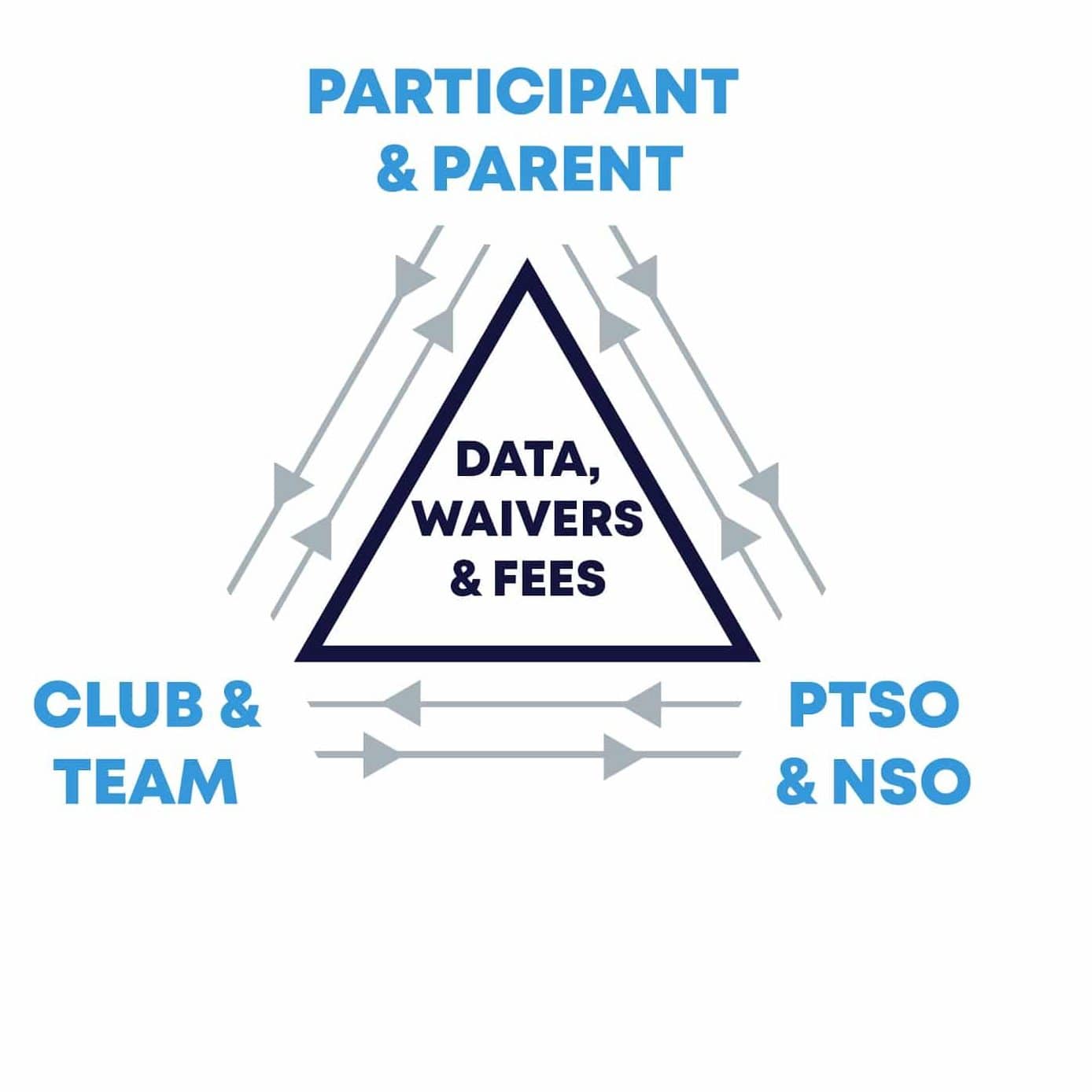
The Traditional Model
The traditional model often involves the club or team collecting and providing member data to the PTSO along with payment for the resepective PTSO and perhaps National Sport Organization (NSO) dues. This model brings numerous challenges that have only become more problematic over the last couple of years. The problems that arise from this model include:
- The PTSO receives secondhand data that is often lacking accuracy of integrity and does not contain sufficient information to satisfy funding bodies and insurance providers.
- The club handles the process of collecting and storing waivers and releases from participants and parents.
- The participant and parents do not have a direct relationship with the PTSO.
- The PTSO is collecting fees late, and in some cases then remitting a portion of fees to the NSO.
We’ve observed numerous initiatives to evolve this, some very successful and some not so successful. The most common approach being where the PTSO instructs the clubs not to collect registrations, waivers and dues on behalf of the PTSO anymore, and providing the options to either 1) Use an integrated registration system for club registration that includes the validation and purchase of the PTSO membership in one experience or 2) Instruct all the participants to visit PTSO registration system directly to sign up and pay their dues.
The former option is not always possible for clubs, as sometimes they have invested in their own system or are contractually committed to a specific provider. The latter option is also not ideal as it makes for a fragmented process for the participant as they register for the club and the PTSO separately. This leads to an increased risk, as the club will be responsible for ensuring all of their members are holding a valid PTSO membership.
The Impacts of 2020
The impacts of 2020 and Covid-19 brought even more reasons to evolve from these traditional processes, and we’ve seen an increase in organizations leveraging technology to make athlete data collected by affiliated clubs, including their signed waivers, integrated to PTSOs. This presents many benefits including more direct communication between PTSO’s and their athletes and parents. As well as enabling the PTSO to ensure that every member has the correct memberships and waivers, and that coaches have completed criminal background checks. These types of integrations helps remove the burden of compliance from clubs, which tend to have varying degrees of resources and technical sophistication. These integrations also help provide PTSOs with realtime accurate data for operational and strategic reporting purposes e.g. to funding bodies, sponsors, retention and growth efforts.
The most obvious technical solution to integration is having all of the clubs use the same system for registration as the PTSO. While this would make for the smoothest path for both administration purposes and members, implementation can be a complicated journey. With that said, we have seen some sporting organizations make the most of these unusual times during the pandemic to achieve changes that would normally have taken years through reluctance to adapt.
Different Solutions for PTSO Integration
We thought it would be interesting to explore three different solutions for integrating affiliations with sport organizations, that not only reduce risk but help government bodies achieve overarching goals and strategy plans. Before looking at solutions, we must look at the requirements related to the integration and processes of sporting organizations, and the member organizations affiliated with them.
PTSO Requirements:
- Build a direct relationship and communicate with the parent or guardian of each athlete, coach, official, volunteer or others in an oversight role.
- Ensure that agreements, declarations, and waivers are consistently handled & stored for future potential retrieval
- Manage the official criminal background checks for coaches and others in an oversight role
- Effectively split and deposit the fees for the National Sporting Organization (‘NSO’) and PTSO in a timely manner
- Ensure membership funds collected by the club/team affiliate are collected in a timely and efficient manner that does not lead to accounts receivables and chasing
Club or Team Affiliate Requirements:
- Ensure that every participant’s PTSO membership is valid.
- Ensure that the legal guardian or parent has completed any necessary agreements or releases.
- Remit the funds collected on behalf of the PTSO/NSO to the PTSO as applicable
The Three Common Scenarios for Affiliated Clubs
Below we have outlined what we see to be the three most typical club-to-PTSO relationship structures and rated the user experience as well as discussing how the processes can be best implemented.
Club Scenario #1 – Two Separate Registrations
In this scenario, the club is using a different registration system than their PTSO, and sends members to use the PTSO registration system to complete and pay their PTSO membership. This type of club also needs validation processes to ensure that each member has fully paid their membership dues.
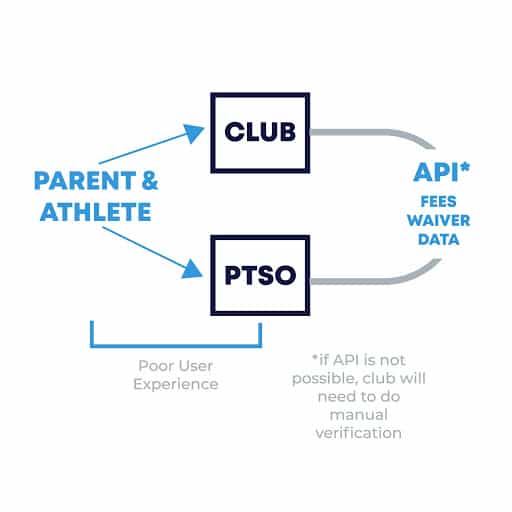
Rating: 5/10
User Experience
For the purchaser, the registration process is fragmented. Participants need to use multiple systems, and make separate payments. They will be required to enter similar information twice and often there will be a lag between signing up for the club and then the PTSO. It creates extra work for the purchaser (a barrier to entry for growth) and does not project an integrated sport image where the PTSO/NSO are part of the grassroots community.
Club Experience
If an application-process interface (‘APi’) is not possible with the clubs chosen platform to the PTSO chosen platform, the club will have to manually validate each applicant’s membership, as well continually checking if it is in good standing. There is the potential where a person could be involved in a club activity who does not have required PTSO membership (and therefore potentially insurance) for which the burden of any claim may fall on the club and its officers/directors.
PTSO Experience
Not all members of a club may sign up for the PTSO membership, therefore depriving the PTSO of membership revenue, but also numbers of members (which may impact both funding grants and sponsorship revenue). There is likely to be additional administration in liaising with clubs (e.g. clubs enquiring if X person has PTSO membership and if it is valid-especially true when it comes to technical licenses such as coaches and officials).
Implemented solutions:
If this path is chosen by a PTSO, the club registration flow should involve sending the registrants to the PTSO’s website to complete the membership application. The club’s registration system should use an API verification process to ensure that was done (i.e. that the person has a valid PTSO membership). It could involve using a membership number or a match of the applicant’s name. With an APi, the system can see if the PTSO membership is valid. The registrant can then sign up for the right activity.
The downside
The member will have to leave the club registration process to complete the PTSO membership and then return to the club to sign up afterwards.
Club Scenario #2- One Registration, Data is Passed to PTSO
In this scenario, the club does not want each member to register themselves with the PTSO system or directly pay the PTSO for their membership. Instead, the club collects the PTSO membership dues and PTSO waiver for members and submits the data to the PTSO to create a current membership record.
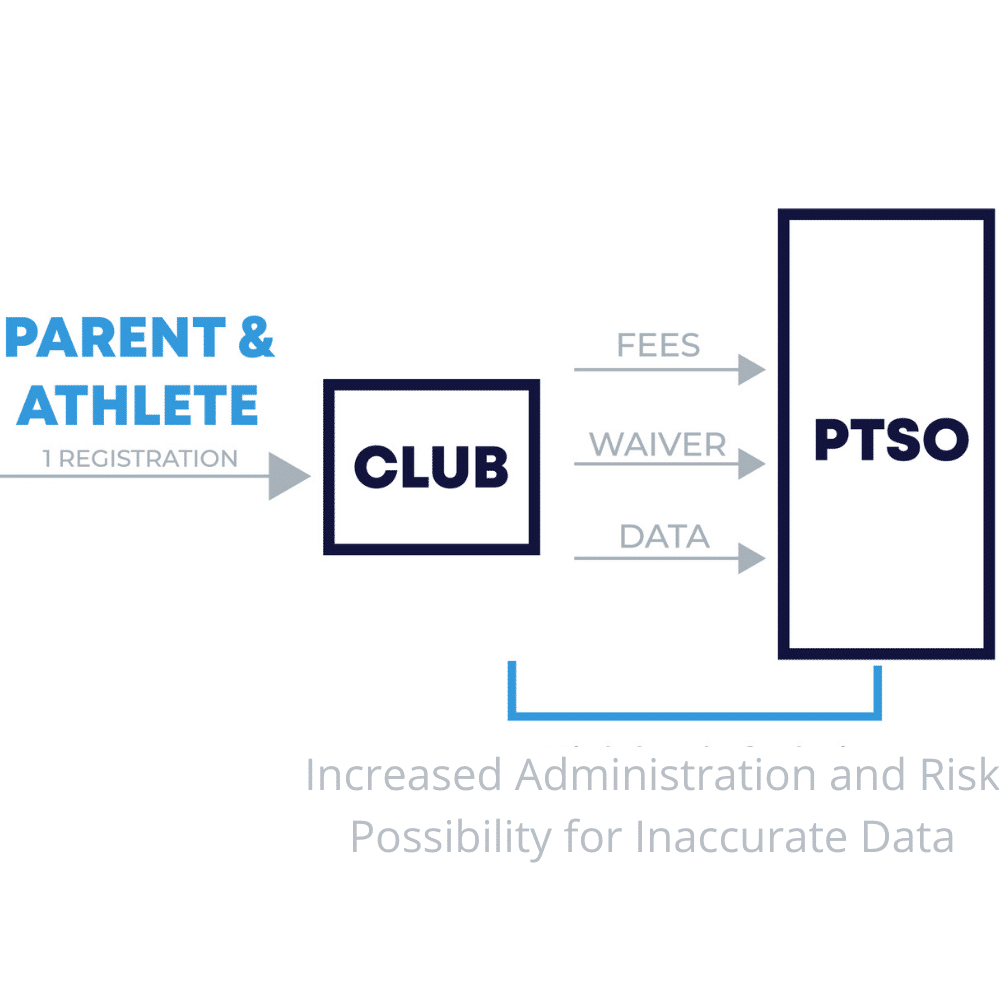
Rating 7/10:
User Experience
From a user perspective, they only have to go to one site to complete and pay for their registration (or do so by paper).
Club Experience
From a club perspective, there is administration and risk in managing the PTSO membership waiver collection and dues. As well as carrying the burden of having to obtain waivers and payments from the user, there is the administration of sending it to the PTSO as well as storing the PTSO waiver. There is the unfortunate incentive to not fully report or remit.
PTSO Experience
The PTSO has almost zero interaction with their members and is placing great trust in the hands of every club to administer and safeguard waivers. The PTSO can never be 100% confident that they are receiving all the funds they should and there will definitely be delays in receiving the funds from the clubs (as well as administration around accounts receivable, invoicing etc.).
The Solution:
One solution for this scenario is to ensure that the clubs do their annual affiliation with the PTSO on the PTSO registration software. This will enable an environment where the club can also bulk import athlete records to make a PTSO membership for each applicant.
Once uploaded, each club member/ parent will then get a confirmation email informing them that their PTSO membership has been paid for, but to become valid, the parent or applicant has to agree to the required PTSO waivers or agreements via a link in the email. Upon completion, the member can get their digital membership card, membership number, and confirmation email. Upon bulk upload of their club members into the PTSO system, the club can settle the funds owing to the PTSO at point of upload.
This hybrid model does achieve the requirement to ensure that each member of the PTSO has agreed to the terms and conditions of PTSO membership (as well as its benefits such as insurance) and that the PTSO receives its funds (or is at least aware of what is owed). For clubs, it still enables them to manage their memberships directly, but adds some peace of mind with respect to risk management.
The downside
The clubs need to make sure they collect the right data from all the members, such as; if the registrant is a minor at the time of registration the club must collect a name, email and relationship type for the parent or guardian. Then the club needs to prepare the data into the importable format based on a spreadsheet template.
Club Scenario #3- One Registration with Integrated Data, Waivers & Fees
In this scenario, the club uses the same registration software as the PTSO, whereby the individual signs up for the club and PTSO (and NSO and even International body) at the same time, agreeing to the waiver/t&c of both club and PTSO.
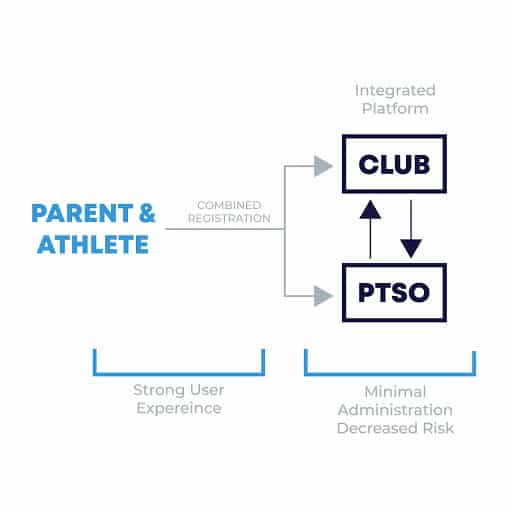
Rating 10/10
User Experience
The user only has to enter her/his information and pay once, is made aware of the PTSO/NSO connection/membership and can now enter events, clinics/other run by the club/PTSO without any further checks.
Club Experience
Collection of PTSO waivers and remittance of PTSO funds are removed from the club responsibility-just the clubs funds are remitted to the club, significantly reducing administration. The club officers/directors know that a member could not possibly sign up for their club without having the appropriate PTSO/NSO membership and any insurance benefit.
PTSO Experience
The PTSO receives funds promptly, it establishes a relationship with the member directly, has accurate reporting for funding bodies, insurance brokers, sponsors and other stakeholders and hugely reduces both the risk and administration around collection of membership dues. By having this data, it can overtime start to analyse retention of members, average lifetime of a member, diversity targeting/reporting as well as long-term athlete development identification.
Solutions:
In this scenario, the club can set up the registration for merchandise, programs, and memberships using the Uplifter platform, the same as their PTSO. Members can apply for their club and PTSO memberships at the same time, and pay for the two orders in one transaction. They will receive confirmation emails from both organizations and on the system’s backend, the fees will be split and the waivers and athlete data will be accessible to the PTSO.
The downside:
Not all clubs or teams are in a position or interested to move from their current registration process. Online registration does not work for all affiliates, such as a school team that collects paper forms and covers the cost of the team members to be part of the PTSO.
A Word From Our Partners, Markel Canada Limited
At the start of 2020,Uplifter announced a strategic partnership with Markel Canada Limited, the division of Markel International that provides insurance solutions for commercial liability needs across Canada. This partnership united Uplifter’s technology facility with Markel’s deep industry knowledge and insurance expertise in order to help sport organizations reach a faster realization of effective systems around safe sport. With the pandemic’s detrimental effects on sport organizations, the need for risk mitigation services in the pursuit to return to sports in 2021 has become crucial.
In our increasingly litigious society, data collection and processes to help promote safety are becoming key factors in all activities, but especially sports. A streamlined user experience linking participants to their governing bodies is, no doubt, the key tool in allowing organizations to begin their return to sports with peace of mind. Gina Bennett, Vice President of Markel Canada’s Sports, Leisure, Fitness and Recreation sector comments “while the lasting effects of Covid-19 on our economy is unknown, an irrevocable focus for all organizations moving forward will be the safety measures they will have to put in place. As the above scenarios outline, a streamlined process between participants and their governing bodies is the simplest, safest way to ensure that waivers are being properly collected and stored, health checks are being performed, and that PTSOs, NSOs, and participants and their families are privy to all of the same information. Markel Canada’s partnership with Uplifter will be instrumental for our insureds in the post-pandemic return to play”.
For national and provincial sport organizations under pressure to comply with new governance or insurance standards, this partnership creates the opportunity for sport organizations to use a systematic multidisciplinary and multi-agency approach. With Markel as Uplifter’s official insurance partner, using this technology may result in premium savings to reflect an improvement in mitigated risk.
Concluding Thoughts
Clubs and teams are a critical part of the sport ecosystem and have a wide wide variety of needs and operating processes. It is not always realistic to try and get all clubs and teams to follow the same process and all on one system. As a technology partner to clubs, PTSOs, NSO’s we understand the importance of enabling the organizations to utilize a system that can handle all of these different processes at the same time. Hopefully the realization of the need to evolve processes occurs more organically than as a result of a major incident.
The greatest successes will be the PTSO’s that are able to offer all of these three approaches simultaneously and give their clubs/ affiliates the option to choose which approach works best for them, offering flexibility for clubs while ensuring safe sport and covid-19 policies are being met.
We would love to hear your thoughts or questions in the comments below, or join the conversation online @Upliftertech on socials. If you would like to talk one-on-one with our leadership team we are happy to discuss best practices and obstacles you may have.
You can book a free consultation here.
About Uplifter Technology
Uplifter works with National and Provincial Sport Organizations, sport clubs and events to provide modern and flexible systems for registration and membership management that can unify events, clubs, PTSO’s and the NSO under one platform. Since Uplifter began operations in 2009, they have supported more than 20 National Organizations, over 100 Provincial bodies, and thousands of sport clubs with a wide range of services. Outside of registration and membership management, terpodia’s ecosystem provides safe sport and risk management tools, and also acts as a hub to integrate with other vertical specialists such as communication tools like MailChimp, merchandise design and fulfillment centers, and background check systems.
Uplifter Explore l’Évolution des Processus entre les OSPT et les Clubs Affiliés
Dans cet article, nous examinerons les interconnexions entre les Organisations Sportives Provinciales/Territoriales (OSPT) ainsi que leurs équipes et clubs affiliés dans le contexte de l’évolutions des processus de collectes et de partage des données, et l’impacte que ces processus peuvent avoir sur la gestion des risques, le sport sécuritaire et plus encore.
Pourquoi ce sujet est-il intéressant? Ces 18 derniers mois, Uplifter à travaillé avec plus d’une centaine d’instances provinciales, à travers 22 sports différents du soccer au patinage de vitesse. La réalité est qu’il est difficile pour une OSPT de trouver un modèle qui fonctionne pour tous les clubs/équipes et que le besoin de création de relations directes et pertinentes avec les participants et parents au sein des clubs est en hausse.
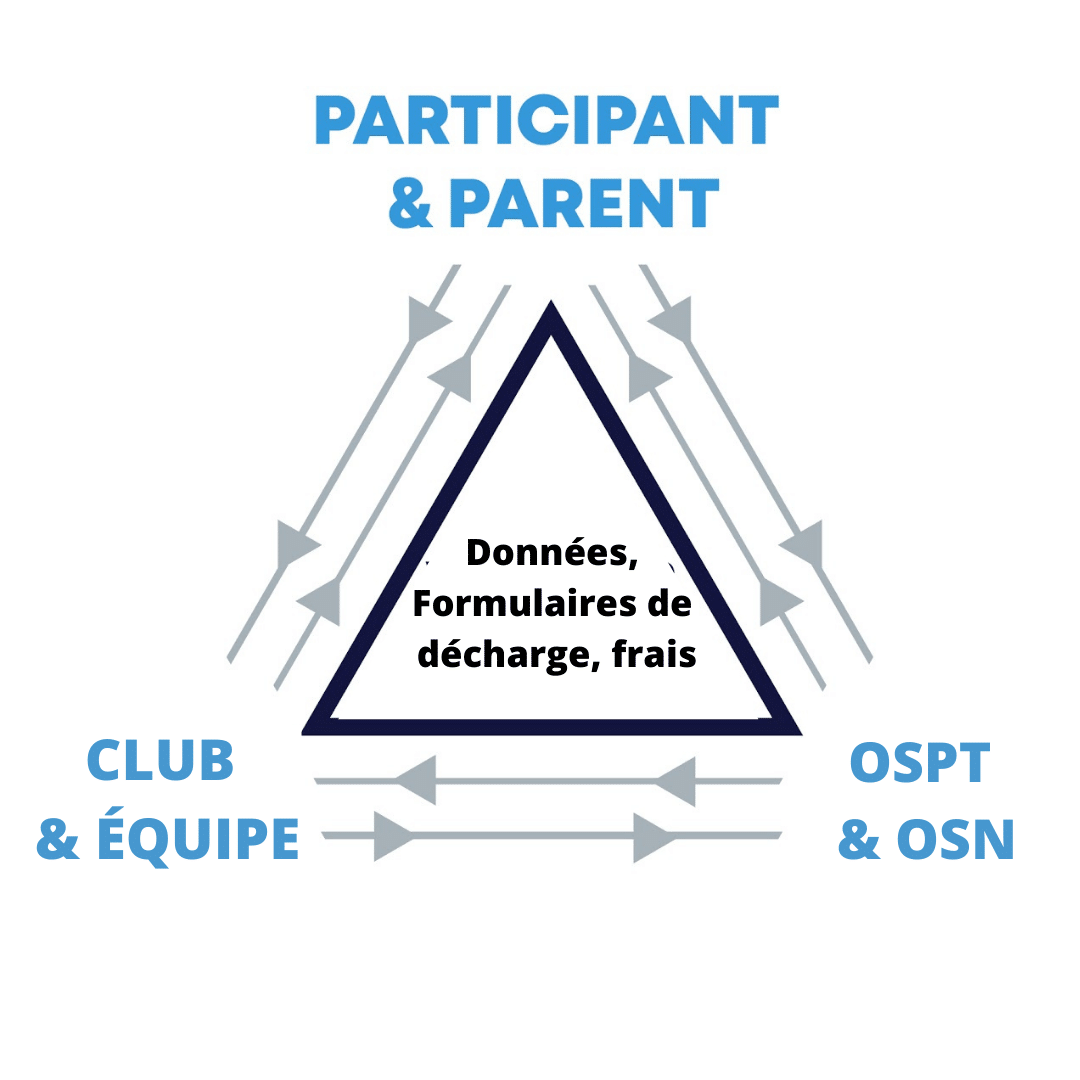
Le Modèle Traditionnel
Le modèle traditionnel veut que le club ou l’équipe collecte et fournisse les données des membres à l’OSPT accompagné des paiements à verser à l’OSPT et parfois à l’Organisme Sportif National (OSN). Ce modèle comporte de nombreux défis qui sont devenus plus problématiques ces dernières années. Les problèmes qui surgissent avec ce modèle incluent:
- L’OSPT reçoit des données extérieures qui manquent souvent d’exactitude et d’informations nécessaires pour satisfaire les organismes de financement et les assureurs.
- Le club se charge de collecter et stocker les formulaires de décharge des participants et parents.
- Les participants et les parents ne sont pas en relation direct avec les OSPT
- L’OSPT collecte les paiements en retard, et dans certains cas transfert une portion à l’OSN
De nombreuses initiatives ont été observées concernant l’évolution de ce modèle, certaines efficaces et d’autres non. L’approche la plus courante est celle ou l’OSPT demande au club de ne plus collecter les frais d’inscriptions ni les formulaires de décharge au nom de l’OSPT, en donnant deux options 1) Utiliser un système d’inscription intégré pour les membres du club qui inclut l’achat et la validation de l’adhésion à l’OSPT en une seule fois. 2) Demander à tous les membres de se rendre sur le système d’inscription de l’OSPT pour s’inscrire et payer.
Cette dernière option n’est pas toujours possible pour les clubs car ils ont souvent investi dans leur propre système ou sont contractuellement lié à un fournisseur spécifique. De plus, cette option n’est pas idéale car elle crée un processus fragmenté pour les participants qui doivent s’inscrire au club et à l’OSPT séparément. Cela peut conduire à des risques accrus pour le club tenu responsable de s’assurer que tous leurs membres doivent être en possession d’une adhésion à l’OSPT valide.
L’impact de l’Année 2020
L’impact de l’année 2020 et de la Covid-19 à mis en lumière encore plus de bonnes raisons de s’éloigner de ce modèle traditionnel, nous avons constaté une augmentation du nombre d’organisations mettant à profit la technologie afin d’intégrer la collecte des données et des formulaires de décharge avec les clubs et OSPT. Cela apporte beaucoup d’avantages tels qu’une meilleure communication entre les OSPT et leurs athlètes et parents et la possibilité pour les OSPT de s’assurer que chaque membre possède les bonnes adhésions et signe les formulaires appropriés et que chaque entraîneur ait validé sa vérification d’antécédents judiciaires. Ce genre d’intégration permet au club de se décharger du poids de la conformité, ils ont souvent accès à des degrés différents de ressources et de sophistication technique. Ces intégrations permettent également aux OSPT de bénéficier de données fiables utilisées pour le financement, les sponsors, la rétention et l’expansion.
La solution d’intégration la plus évidente est l’utilisation du même système d’inscription pour l’OSPT et le club. Même si cela perfectionne les procédés pour chaque organisation et ses membres, son implémentation peut se révéler compliquée. Ceci dit, nous avons observé beaucoup d’organisations sportives tirer le meilleur de cette période incertaine de pandémie, ils ont pu rendre des changements possibles qui généralement aurait pris des années à se mettre en place par réticence.
Des Solutions Différentes pour l’Intégration des OSPT
Nous pensons intéressant d’explorer trois solutions différentes concernant l’intégration des affiliations entre les organisations sportives qui non seulement réduisent les risques mais aident également à atteindre des objectifs et plans stratégiques. Avant de jeter un œil à ces solutions, il est important de connaître les exigences liées à l’intégration et aux processus des organisations sportives ainsi que les organisations affiliées.
Exigences des OSPT:
- Construire une relation et une communication directe entre les parents ou tuteurs légaux de chaque athlète, entraîneur, officiel, bénévole ou autres.
- S’assurer que les accords, attestations et formulaires de décharge soient gérés et stockés pour de futurs besoins.
- Gérer le contrôle des antécédents judiciaires des entraîneurs et personnes concernées
- Diviser et remettre les paiements respectifs aux organisations sportives nationales (OSN) et OSPT en temps voulu.
- S’assurer que les paiements des adhésions soient collectés par le club/l’équipe affiliée en temps voulu et de manière efficace qui ne mène pas à des poursuites.
Exigences des Clubs/Équipes Affiliées
- S’assurer que chaque participant possède une adhésion à l’OSPT valide.
- S’assurer que le parent ou tuteur légal a rempli les formulaires et accords requis.
- Remettre les fonds collectés au nom de l’OSPT/OSN
Les Trois Scénarios les Plus Communs pour les Clubs Affiliés
Ci-dessous, nous avons mis en exergue les trois structures les plus courantes de relations entre OSPT et Clubs et avons noté les expériences utilisateurs et décrit comment le meilleur procédé peut être mis en place.
Scénario de Club #1 – Deux Inscriptions Séparées
Dans ce scénario, le club utilise un système d’inscription différent de celui de son OSPT. Le club envoie ses membres s’inscrire sur le système d’inscription de l’OSPT afin de payer leurs frais d’adhésion. Ce type de club requiert également un système de validation afin de s’assurer que chaque membre à correctement payé ses frais d’adhésions
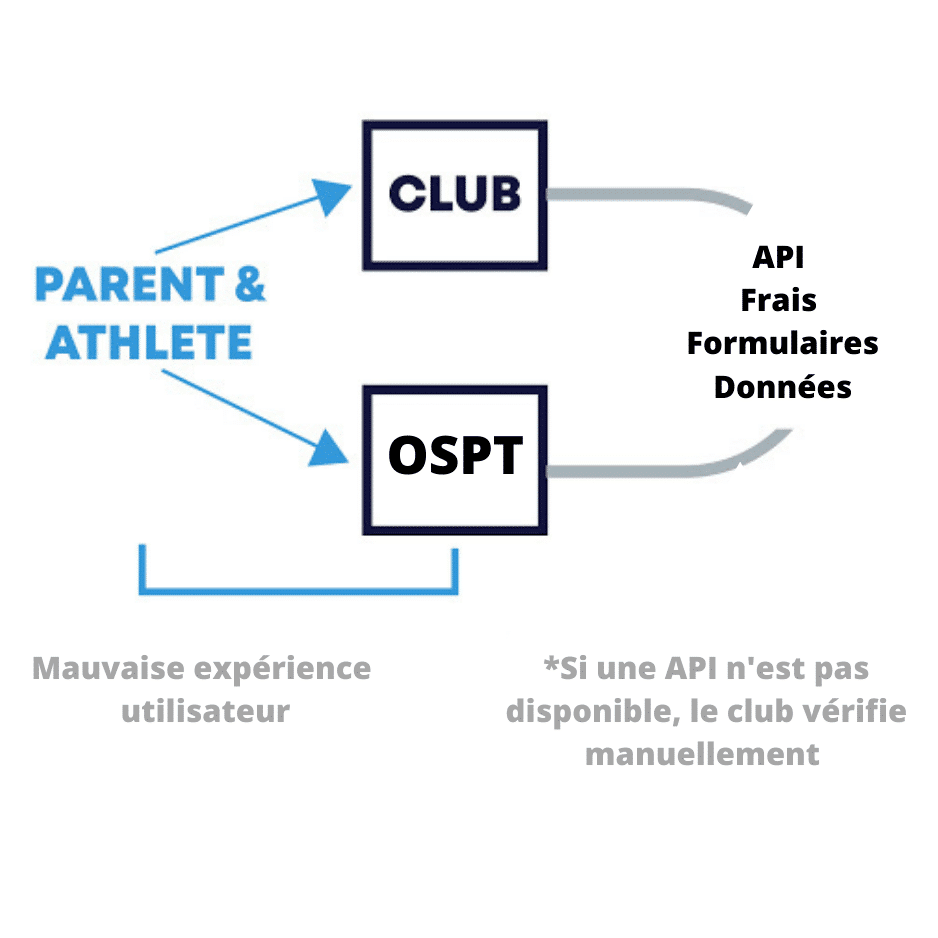
Note: 5/10
Expérience Utilisateur
Pour l’acheteur, l’inscription est fragmentée. Les participants doivent utiliser des systèmes différents et faire des paiements séparés. Ils doivent entrer les mêmes informations deux fois et il y a souvent un décalage entre l’inscription au club et à l’OSPT. Cela crée du travail supplémentaire pour l’acheteur (une barrière à la croissance) et ne reflète pas l’image d’un sport intégré ou les OSPT/OSN font partie de la même communauté.
Expérience du Club
Si une interface de programmation applicative (API) n’est pas possible entre la plateforme du club et celle de l’OSPT, le club doit manuellement vérifier chaque adhésion ainsi que continuellement vérifier quelles sont à jour. Cela laisse la possibilité qu’une personne puisse être active au sein d’un club alors qu’elle ne possède pas l’adhésion requise (potentiellement donc non assurée) toute poursuite est alors de la responsabilité du club et de ses gérants
Expérience de l’OSPT
La totalité des membres du club peuvent ne pas s’inscrire à l’OSPT, réduisant la source de revenus provenant des ventes d’adhésions et le nombre de membres (cela peut impacter les subventions et les revenus des sponsors). La charge administrative liée aux communications avec le club est souvent plus conséquente (ex: le club demande si la personne X possède bien une adhésion valide – c’est particulièrement vrai pour les adhésions techniques commes les entraîneurs ou officiels)
Solution Implémentée:
Si l’OSPT choisit cette option, le processus d’inscription au club doit comprendre l’envoie des membres vers le site de l’OSPT afin qu’ils obtiennent leur adhésion. L’inscription au club doit utiliser une vérification API pour s’assurer que c’est fait (càd si la personne possède une adhésion valide). Cela peut inclure l’utilisation d’un numéro de membre ou la vérification du nom du membre. Avec l’API, le système peut vérifier que l’adhésion à l’OSPT est valide. Le membre peut alors s’inscrire à l’activité souhaitée.
Scénario de Club #2 – Une Seule Inscription – Données Envoyée à l’OSPT
Dans ce scénario, le club ne souhaite pas que chaque membre s’inscrive et remette l’argent à l’OSPT eux-mêmes. À la place, le club collecte le paiement des adhésions à l’OSPT ainsi que les formulaires de décharge puis donne ces données à l’OSPT pour créer une base de données des adhésions.
Disclaimer: This post was originally published under the name Interpodia Technology Inc. As of January 2025, the company is operating under its new name, Uplifter Inc. All references have been updated to reflect this change.
For media inquiries, please contact:
Head of Strategic Development & Partnerships
.svg)
.png)





.png)
.png)
